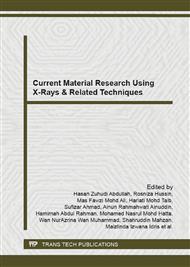p.384
p.389
p.394
p.400
p.405
p.410
p.415
p.420
p.424
Anode-Cathode Position: How it Influences the Radiation Risk to Staff Involved in Fluoroscopy Procedures
Abstract:
It is important to understand that the heel effect contributes higher dose to cathode bound. This study is to verify this effect and consequently utilized it to minimize the radiation dose to staff involved in fluoroscopy procedures especially those using mobile C-arm unit. Water phantom with size of 20 x 30 x 30 cm was used in this study. It was exposed to x-rays from a mobile C-arm unit with auto brightness control (ABC) function. An ion chamber and a solid state detector were used to measure the scattered radiation and primary beam profile. Based on the result it was clear that scattered radiation measured was highest on the cathode bound side. Hence personnel involves in fluoroscopy procedure should avoid or spend the least possible time within this cathode bound area in order to lessen the radiation risk.
Info:
Periodical:
Pages:
405-409
Citation:
Online since:
February 2015
Keywords:
Price:
Сopyright:
© 2015 Trans Tech Publications Ltd. All Rights Reserved
Share:
Citation:


